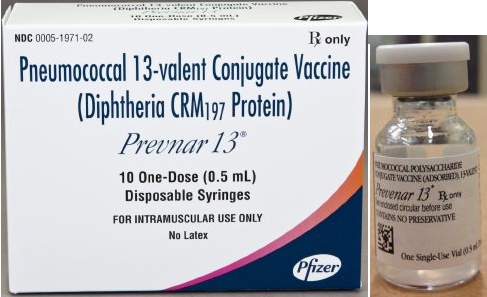
Pneumococcal Conjugate vaccine has been introduced in the NIS under UIP since May 2017.
In the first phase, the vaccine was rolled out in Himachal Pradesh and parts of Bihar and Uttar Pradesh. Introduction in Madhya Pradesh and Rajasthan will follow and eventually be expanded to the country.
Vaccine Type: killed, conjugate vaccine
13 serotypes are individually conjugated to a nontoxic variant of diphtheria toxin.
It is a liquid preparation. After shaking, the vaccine is a homogenous, white suspension.
Doses per vial:
PCV used under UIP is a 4 – dose vial
Storage:
Between +2ºC to +8ºC
In the basket of an ice-lined refrigerator
DO NOT FREEZE; Discard if the vaccine has been frozen.
Can we use the ‘shake test’ to determine if a PCV vial has been frozen?
Yes, suspected frozen vials of PCV can be tested for freezing through ‘Shake Test’ procedure like that for DPT, Pentavalent, TT, HepB vaccines.
Vaccine Vial Monitor:
Type 30
Dose:
0.5 mL
Shake well before use to homogenize the suspension, and only use if the vaccine is a homogenous, white suspension
Route:
Intramuscular
Site:
Anterolateral aspect of the right mid - thigh in infants
Deltoid muscle in older children and adults
The vaccine should not be injected in the gluteal area.
Schedule under UIP
The vaccine will be given as two primary doses at 6 & 14 weeks of age (along with Penta, bOPV, fIPV and RVV) followed by a booster dose at 9 months of age, along with MR-first dose, vitamin-A and JE (in endemic states)
Is Open Vial Policy applicable to PCV?
Yes, PCV13 (4-dose vial) can be used for a maximum of 28 days on the condition:
• Cold chain principles have been respected
• VVM has not reached the discard point
• Expiry date has not surpassed and
• Has met all other criteria of open vial policy i.e.:
o The expiry date has not been reached.
o The vaccine vial monitor (VVM) has not reached the discard point;
o Vaccines are stored in appropriate cold chain conditions, both during transportation and in the cold chain storage point;
o Aseptic technique has been used to withdraw vaccine doses. (That is needle/septum has not been contaminated in anyway); and
o Vaccine septum has not been submerged in water or contaminated in any way.
Side Effects
Infants and Children:
• Injection site reaction,
• fever ( 39ºC),
• irritability,
• drowsiness, restless sleep,
• decreased appetite,
• vomiting, diarrhoea, and
• rash
Protective efficacy:
80% against vaccine serotype invasive pneumococcal disease.
Contraindications:
• Those who have had severe allergic reactions to a prior dose.
• Those who are known to have had a severe reaction to another vaccine containing diphtheria toxoid.
• Those who have a severe illness; vaccination should be delayed until the condition improves.
What types of PCV are available?
PCV is available as PCV10 and PCV13.
Which type of PCV is introduced under UIP?
PCV 13 which contains 13 serotypes of Streptococcus pneumoniae has been introduced under UIP.
Which diseases does the vaccine protect against?
PCV protects children against severe forms of pneumococcal disease, such as otitis media, pneumonia and meningitis.
Why was the need felt to include PCV in the National schedule?
Pneumonia kills more children under-five years of age in India than any other infectious disease. The pentavalent vaccine which was included in the NIS earlier protects against Haemophilus influenzae type b (Hib) pneumonia.
Now, the introduction of PCV in the UIP will reduce child deaths from pneumococcal pneumonia as well.
Which vaccines under UIP help in reducing child deaths from pneumonia?
Currently, three vaccines under UIP have the potential to reduce childhood mortality from pneumonia:
1. PCV
2. Hib-containing pentavalent vaccine and
3. Measles vaccine
PCV and pentavalent vaccines prevent pneumonia due to Streptococcus pneumoniae and Haemophilus influenzae type b respectively.
Measles infection puts children at risk of secondary bacterial pneumonia by:
• Affecting multiple organ systems including the lungs and
• Transiently suppressing the immune response
Measles vaccine prevents the systemic viral infection caused by measles, thereby preventing pneumonia as a complication
Can PCV be given to a premature infant?
Yes, a premature child can and should be vaccinated at or after 6 weeks of age
Is PCV recommended for immune-deficient children?
Yes, regardless of the underlying medical conditions (e.g., children with HIV infection, sickle cell disease or who are otherwise immunocompromised), the national schedule for giving PCV should be followed.
In fact these children are in particular need of PCV because their risk of pneumococcal disease is high.
PCV has been proven to be safe and well-tolerated even among children infected with HIV.
References:
GOI 2017. National Operational Guidelines; Introduction of Pneumococcal Conjugate Vaccine: MoHFW, New Delhi.
Press Information Bureau, Government of India, Ministry of Health and Family Welfare Dated 13-05-2017. Available at: http://pib.nic.in/newsite/PrintRelease.aspx?relid=161763 accessed on 10th November 2017
GOI, MoHFW files, 2017. Available at: https://mohfw.nic.in/sites/default/files/41016395871489662752.pdf accessed on 10th November 2017
Immunization standards, WHO website. Available at: http://www.who.int/immunization_standards/vaccine_quality/pq_222_prevena... accessed on 10th November 2017
Pfizer Gets Pneumonia Vaccine Patent, Months After Inclusion in India’s Universal Immunisation Plan; Featured: The wire dt. 23-8-17. Available at: https://thewire.in/170285/india-gives-pfizer-patent-for-pneumococcal-vac... accessed on 10th November 2017
National Immunization Schedule in India; 2017: http://www.ihatepsm.com/blog/national-immunization-schedule-india-2017
Rotavirus vaccine: http://www.ihatepsm.com/blog/rotavirus-vaccine
Pentavalent vaccine: http://www.ihatepsm.com/blog/pentavalent-vaccine
BACILLE CALMETTE GUERIN (BCG) VACCINE: http://www.ihatepsm.com/blog/bacille-calmette-guerin-bcg-vaccine
IPV (INACTIVATED POLIOVIRUS VACCINE): http://www.ihatepsm.com/blog/ipv-inactivated-poliovirus-vaccine
DT & TT Vaccines: http://www.ihatepsm.com/blog/dpt-and-tt-vaccines
Oral Polio Vaccines (OPV): http://www.ihatepsm.com/blog/oral-polio-vaccines-opv
Measles Containing Vaccines (MCV): http://www.ihatepsm.com/blog/measles-containing-vaccines-mcv
HEPATITIS B VACCINE: http://www.ihatepsm.com/blog/hepatitis-b-vaccine
JAPANESE ENCEPHALITIS (JE) VACCINE: http://www.ihatepsm.com/blog/japanese-encephalitis-je-vaccine
Pneumococcal Conjugate Vaccine (PCV): http://www.ihatepsm.com/blog/pneumococcal-conjugate-vaccine-pcv
RABIES VACCINE: http://www.ihatepsm.com/blog/rabies-vaccine
CONCENTRATED VITAMIN A SOLUTION: http://www.ihatepsm.com/blog/concentrated-vitamin-solution
VACCINE VIAL MONITOR (VVM): http://www.ihatepsm.com/blog/vaccine-vial-monitor-vvm
Adverse event following immunization (AEFI): http://www.ihatepsm.com/blog/adverse-event-following-immunization-aefi
